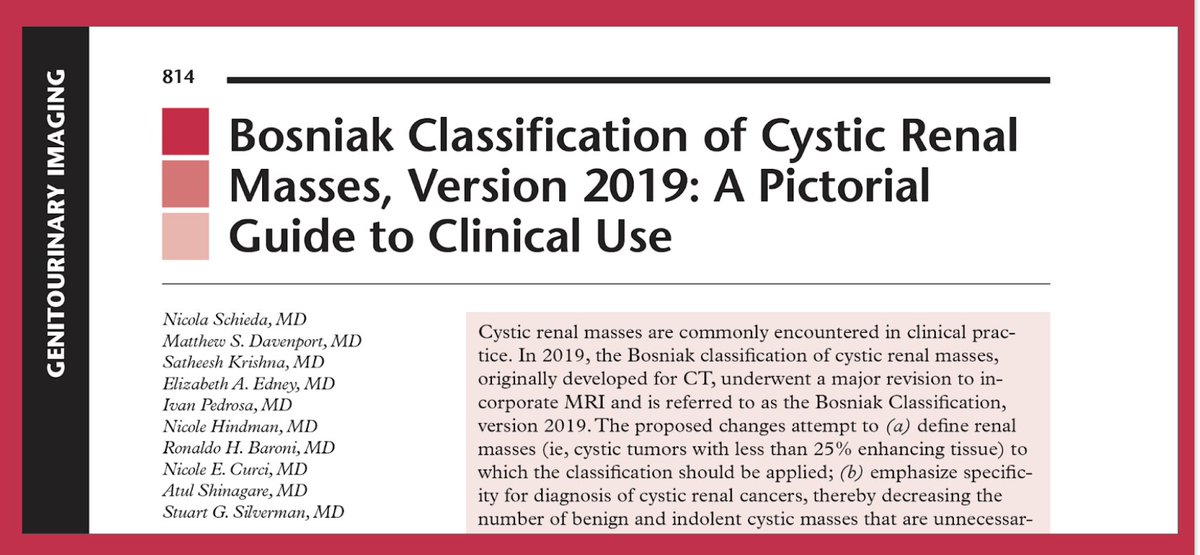
The 2019 Bosniak classification is very helpful to better characterize cystic renal masses. But there are significant changes compared to the prior edition. This pictorial by some of the brightest minds in RCC is exactly what we need to clarify some of the new changes. #RGphx 

Just to understand the reasoning for some of the changes in the Classification, let's start with a quiz; What is the estimated 10-year risk of death from a T1a (<4 cm, limited to the kidney) cystic RCC?
#RGphx @cookyscan1 @RadG_Editor
#RGphx @cookyscan1 @RadG_Editor
Given the low mortality from cystic renal masses, a greater emphasis has been put on specificity rather than sensitivity in the new edition -> a greater number of cystic renal masses are placed into lower Bosniak classes to reduce unnecessary imaging or treatment.
#RGphx
#RGphx
Four important shortcomings of the original Bosniak classification are addressed in the new classification.
#RGphx
@CookyScan
@RadioGraphics
#RGphx
@CookyScan
@RadioGraphics

What I love about the new classification is how comprehensive these definitions are (to reduce inter-observer variability) - the grey-zone Bosniak II and IIF classifications are expanded and more clear.
#RGphx
@CookyScan
@RadioGraphics
#RGphx
@CookyScan
@RadioGraphics

The revised classification explicitly recommends MRI to further evaluate indeterminate masses at CT that (a) show abundant thick or nodular calcifications, (b) are homogeneously hyperattenuating and larger than 3 cm, or (c) are heterogeneous and non-enhancing.
#RGphx
@cookyscan1
#RGphx
@cookyscan1

Enhancement is present when an increase in attenuation or signal intensity after contrast administration is perceived visually or quantitatively: (a) a 20 HU or greater rise (CT); or (b) a 15% or greater signal intensity increase on Gad+ T1-weighted MR images.
#RGphx
@cookyscan1
#RGphx
@cookyscan1

Renal mass protocol CT must include:
▶️Non-contrast images
▶️Nephrographic phase: 100–120 seconds (3 mm thick).
The following are important as well:
▶️Corticomedullary phase: 30–40 seconds
▶️Urographic phase: 5 minutes
#RGphx
@cookyscan1
▶️Non-contrast images
▶️Nephrographic phase: 100–120 seconds (3 mm thick).
The following are important as well:
▶️Corticomedullary phase: 30–40 seconds
▶️Urographic phase: 5 minutes
#RGphx
@cookyscan1

Nice flowchart showing how to approach a cystic renal mass on CT using the 2019 Bosniak classification. Copies of this should be laminated and put on every reading station in the country 😄
#RGphx
@cookyscan1
@RadG_Editor
#RGphx
@cookyscan1
@RadG_Editor

Renal mass protocol MRI includes:
▶️ T1- and T2-weighted images
▶️ T1-weighted chemical shift images
▶️ Fat sat dynamic T1-weighted images obtained before and after IV gad
#RGphx
@cookyscan1
@RadG_Editor
▶️ T1- and T2-weighted images
▶️ T1-weighted chemical shift images
▶️ Fat sat dynamic T1-weighted images obtained before and after IV gad
#RGphx
@cookyscan1
@RadG_Editor

Another nice algorithmic approach to cystic renal masses from the paper - this time when reading MRIs.
#RGphx
#RGphx

In summary, I find the new Bosniak classification a great step in the right direction leading to a decrease in unnecessary interventions and less frequent follow-ups in patients with cystic renal masses.
#RGphx
@cookyscan1
#RGphx
@cookyscan1
One caveat is the patients who are genetically predisposed to RCC. These patients often don’t follow these rules and should not be assessed with Bosniak classifications - fortunately, these are rare.
#RGphx
#RGphx
• • •
Missing some Tweet in this thread? You can try to
force a refresh



